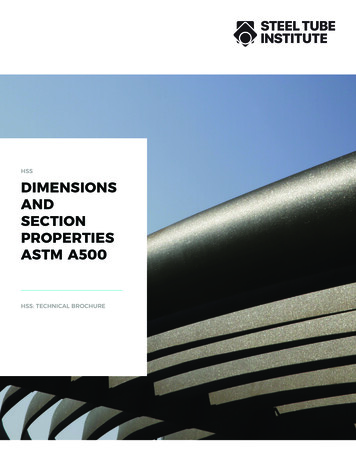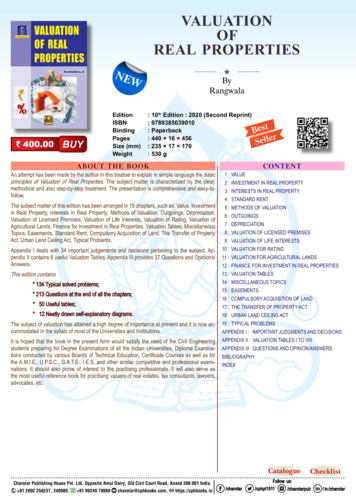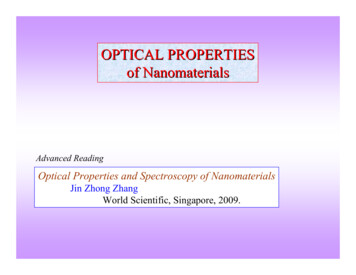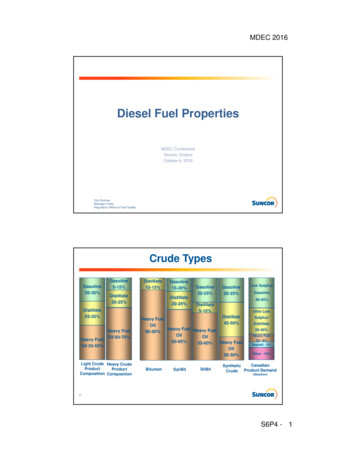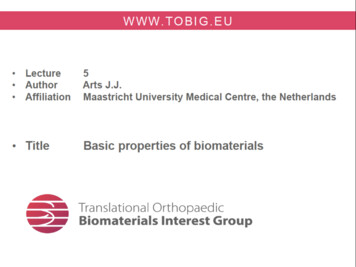
Transcription
Lecture 5:Basic properties of biomaterialsDr. Chris ArtsAssociate Professor Translational biomaterials researchDept. Orthopaedic surgeryMaastricht University Medical Centre j.arts@mumc.nlDept Orthopaedic biomechanicsEindhoven University of technology TU/ej.j.c.arts@tue.nl
Lecture 5:Basic properties of biomaterialsDr. Chris ArtsAssociate Professor Translational biomaterials researchDept. Orthopaedic surgeryMaastricht University Medical Centre j.arts@mumc.nlDept Orthopaedic biomechanicsEindhoven University of technology TU/ej.j.c.arts@tue.nl
Contents1 Preface 3Definitions- Bone- Biomaterial, scaffold- Bioactivity, biocompatibility- Osteointegration osteoconductivity, osteoinductivity Ca-P ceramics properties- Chemical properties: composition, Ca/P ratio, crystallinity, gradient- Structural properties: porosity, interconnectivity- Mechanical properties: creep, stiffness, Young’s modulus- Degradation properties.4 - 11468912 - 2414171920
DefinitionsBone is a living tissue capable of self-repair Bone only forms when mechanical loading is present (Wolff’s law) Bone is continuous being renewed; balance between osteoblasts forming bone and osteoclasts resorbing bone This process of constant bone resorption and bone formation is called bone remodelingFunctions of bone Stabilise and support body Protection of internal organs and soft tissue Rigid parts of the human movement system Storage of minerals and fatty acids Production of blood cells through bone marrow haematopoiesis4
DefinitionsBone is a living tissue capable of self-repair Bone only forms when mechanical loading is present (Wolff’s law) Bone is continuous being renewed; balance between osteoblasts forming bone and osteoclasts resorbing bone This process of constant bone resorption and bone formation is called bone remodeling This process is also called “creeping substitution” 17 The osteoclastic resorption of dead bone from the allograft and its replacement by new living bone made byosteoblasts from the host. Gradual penetration across a fracture site by osteogenic tissue followed by bone formation5
Definitions6Biomaterial A natural or synthetic material that is suitable for introduction into living tissue. 1 A synthetic material used to replace part of a living system or to function in intimate contact with living tissue. 2 A biomaterial is a substance that has been engineered to take a form which, alone or a a part of a complex system isused to direct, by control of interactions with components of living systems, the course of any therapeutic ordiagnostic procedure. 3Scaffold Temporary framework used to support people and material in the construction or repair of buildings. In regenerative medicine the more commonly used definition is: “An artificial structure capable of supporting 3-Dtissue formation.” 4 To allow bone formation a scaffold should allow : attachment, proliferation, migration, and phenotypic expression ofbone cells leading to formation of new bone in direct apposition to the Ca-P biomaterial. 2,5
DefinitionsScaffold purpose 6-9 Allow cell attachment and migrationDeliver and retain cells and biochemical factorsEnable diffusion of vital cell nutrients and expressed productsExert certain mechanical and biological influences to modify the behaviour of the cell phase differentiationDepending on application a scaffold must be 6-9 Biocompatible and biodegradableMechanically stable over timeAble to incorporate any chemical, or biological cues desiredAdequate permeable to allow fluid flow and diffusionUnable to elicit an inflammatory reactionThe ideal scaffold should be: Should be implantable through a minimal surgical exposureApplicable for various indicationsShould be moldable to conform to and fill irregular defectsShould posses roughly the same visco-elasticity as boneShould be as as rigid and strong as intact bone for immediate load-bearing capabilityShould promote new bone formation and incorporation by host boneShould be available in large quantities and it should be cheapDOES NOT EXIST!7
Definitions8Bioactivity 2, 11 The ability of a material to have interaction with or effect on any cell tissue in the human body.2 The ability of a material to form a direct bonding with the host biological tissueBiocompatibility 2,11 The ability of a material to perform with an appropriate host response in a specific situation. Ability of a material to be in contact with a living system without producing an adverse effect.Biocompatibility of a material-host system 5 Prof. D.F. Williams postulated that biocompatibility of a specific material does not exist. Instead the definition shouldbe broadened and should state: biocompatibility of a material-host system. Refers to the ability of a biomaterial to perform its desired function with respect to a medical therapy, without elicitingany undesirable local or systemic effects in the recipient or beneficiary of that therapy, but generating the mostappropriate beneficial cellular or tissue response in that specific situation, and optimizing the clinically relevantperformance of that therapy.5
DefinitionsOsteointegration92,12 The property of a material that allows development of a direct, adherent and strong bond with the surrounding bonetissue. The formation of a direct interface between an implant and bone, without intervening soft tissue.Osteoconductivity2,10-11 The ability of a scaffold to facilitate new bone formation by allowing bone cells to adhere, proliferate, and formextracellular matrix on its surface and pores Primarily based on mechanical stimuli as well as chemical composition and geometry of the material Passive processOsteoinductivity2,10-11 The ability to induce new bone formation through molecular stimuli recruitment and differentiation in a controlledphenotype or particular lineage promote cellular functions leading to new bone formation Active process
10Osteopromotive (DBMs), Osteostimulative(bioglass), Osteosupportive 13-15Osteopromotive (DBMs)Describes a material that promotes the de novo formation of bone.It will not contribute to de novo bone growth but serve to enhance the osteoinductivity of osteoinductive materials.Osteostimulative (Bioactive glasses, ceramic BGS)An osteostimulative material needs an osseous defect that provides nutrients (blood) to stimulate bone growth.Effectively promotes new bone growth ,accelerating bone remodeling.In addition, a synthetic bone graft that is osteostimulative will not grow ectopic bone.Osteosupportive No definition found in literature.
11Osteoinductivity (critical look) Osteoinduction is too widely defined and often used when not supported (DBMs) It should be defined according to location in the body and timeline ! Example:Calcium phosphate materials have an intrinsic affinity to bind BMPs. If these materials are implanted in a ectopic location (suchas a muscle) they might initiate bone formation directly or they might accumulate BMPs which when in sufficient numbersinitiate bone formation at a later time-point on in a very friendly environment (availability of stem cells and good blood supply). Are both processes osteoinduction ?
Ca-P ceramics properties12Ca-P ceramics Refers Ancient Greek “Keramos” means pottery Made from inorganic, non-metallic materials with a crystalline structure, usually produced by sintering(processing at high 1200 C temperature) Most ceramics are hard, porous yet brittle The osteoconductive Ca-P biomaterials allow: attachment, proliferation, migration, phenotypic expression of bonecells leading to formation of new bone in direct apposition to the Ca-P biomaterialLeft: ceramic TCP-HA granules with macroporosity.Right: Sintering production of large HA blocks at hightemperature.
Ca-P ceramics properties overview13Compositioncrystallinity / Ca-P nectivityCHEMICALPROPERTIESBiological & Mechanicalcharacteristics of Ca-PceramicssinteringMECHANICALPROPERTIESCreep/ stiffnessYoung’s modulusDEGRADABILITYsurface areaDEGRADABILITYSpeed of resorptionChemical /cellular?particle size
Ca-P ceramics chemical propertiesComposition Refers to the original base components of the material: Hydroxyapatite (HA) [Ca10(PO4)6(OH)2] Tri-calcium phosphate (TCP) [Ca3 (PO4)2 Biphasic: percentage combination of HA & TCP in same material Hybrid: One of the above with added material such as Si, Mg or Bioactive glass Composition has an effect on: Mechanical properties (impactability strength, stiffnes, Young’s modulus) Biological properties (osteoconduction) Degradability speed Rules of thumb: n:Degradation:TCP less brittle in dry formulation compared to HATCP quicker loss of mechanical strength compared to HA in vivoTCP chemically less stable compared to HATCP possesses high resolution characteristics compared to HATCP easily resorbed by osteoclasts compared to HATCP faster degradation (12-18 months) compared to HA (2-10 years)14
Ca-P ceramics chemical propertiesCrystallinity Refers to the degree of structural order in a material, less order provides a more amorphous material Crystallinity has an effect on: Mechanical properties (hardness, density) Biological properties (osteoconduction) Degradation properties (speed and type of degradation) Rules of thumb: Strength: Resorption: Degradability:High crystallinity provides better stiffer materialAmorphous porous materials enhance bone ingrowth but also biological degradationHigh crystallinity leads to slower degradability due to resistance in dissolution15
Ca-P ceramics chemical properties16Calcium-phosphate (Ca/P) ratio Refers to be a measurement of Ca-P ceramics composition Ca/P ratio Ca-P granules between 1.67 (HA) and 1.5 (TCP) Ca/P ratio Ca-P cements between 2.0 (TTCP) and 1,0 (DCPH) Rules of thumb: Strength: Degradability:High Ca/P ratio provides higher strength when compared to low Ca/P ratioHigh Ca/P ratio 1,67 (HA) leads to slower degradability as compared to Ca/P ratio of 1,5 (TCP)
Ca-P ceramics structural propertiesPorosity 2,16-17 Refers to the fraction of the volume of voids within the material over the total material volume Macro porosity Pores 100 µm -400 µm Provides a scaffold for bone cell colonization Micro porosity Pores 10 µm Allows body fluid circulation (proteins) Allows blood vessel ingrowth ( 30 µm decreased tissue infiltration) Porosity allows for mechanical interlocking between the implant biomaterials and host bone. Porosity regulates cell reactions Porosity effects degradability17
Ca-P ceramics structural propertiesPorosity interconnection 2 Surface porosity Pores only on surface area Mechanically stronger Interconnective porosity Pores throughout entire structure Mechanical weaker Porosity allows for mechanical interlocking between the implant biomaterials and host bone. Interconnective porosity direction possibly can dictate pathway for ingrowing cells Rules of thumb: Strength: Resorption: Degradation:Interconnective porosity mechanical weaker compared to surface porosityInterconnective porosity resorbs faster compared to surface porosityInterconnective porosity degrades faster compared to surface porosity18
Ca-P ceramics mechanical properties19Strength The load carrying capacity of a materialStiffness The resistance to elastic deformationStrain The deformation of a material by a force acting on the materialStrain can be tensile or compressive (plastic or viscoelastic deformation)Young’s Modulus (modulus of elasticity) Unique property of a material; measure of a material to resist deformation and return to its original shapeCreep Permanent deformation under influence of mechanical stressMechanical propertyCortical boneCancellous boneCa-P ceramicsTensile strength (MPa)50-15010-10040-100Elastic modulus (GPa)3-208Compressive strength (MPa)130-2302-12100-900Young’s modulus (GPa)15-420,02 - 0,570-120
Ca-P ceramics mechanical properties20Strength The load carrying capacity of a material Elastic modulus, compressive strength and tensile strength are highly dependent on the position of the body andthe condition of the individual. 11 Mechanical properties of bone vary with depending on load orientation with respect to the orientation of tissue(anisotropy) and the speed to which the load is applied (viscoelasticity). 11Rules of thumb: Strength:Strength:Strength:Strength:Material strength primarily dependent on composition, structure, porosity and elasticityCa-P ceramics strong under compression and weak under torsion loadsCa-P cement compressive modulus stronger compared to Ha or TCP granulesTCP quicker loss of mechanical strength compared to HA in vivo
Ca-P ceramics degradation properties21Degradation Degradation refers to a chemical process resulting in the cleavage of covalent bonds due to hydrolysis, oxidation orenzymatic processes (Bio)degradation or resorption is chemical breakdown of an implant by a chemical agent (enzyme, cell, organism) Erosion refers to physical changes in size, shape or mass due to degradation, dissolution, ablation or wear Erosion can be distinguished into surface erosion and bulk erosion Degradation/resorption has an effect on: Mechanical properties (impactability, strength, stiffnes, Young’s modulus) Biological properties (osteoconduction) Degradability speed Rules of thumb: TCP chemically less stable compared to HA due to high resolution characteristics TCP easily resorbed by osteoclasts compared to HA TCP faster degradation (12-18 months) compared to HA (2-10 years)
Ca-P ceramics degradation properties22In vitro & in vivo dissolution of Ca-P materials depends on: CompositionCrystallinityCa/P ratioInterconnectivityDegradability / type and speed of resorptionMechanical propertiesParticle sizeSurface areaProduction processPatient characteristics: age, gender, health status, co-morbiditiesBSOCCreeping substitution:. TRAP stained osteoclasts (redcells and arrows) degrade the surface of a Ca-Pceramic (BS) and behind them a osteblast front (bluenuclei) is forming.Ca-P bone substitutes have to be intact long enough forbone ongrowth to occur and to maintain stability.
Ca-P ceramics properties: bone remodelingstabilityTotal stabilityInitial nced bone remodelingFailureSlow bone remodelingFailureFast biomaterial resorption23
Ca-P ceramics properties24Ca-P ceramics design considerations 2,11 Mechanical properties: mechanical properties such as elastic modulus, tensile strength, fracture toughness, fatigue,and elongation percentage should be as close as possible to the replaced tissue (mechanical compatibility) in orderto prevent bone loss, osteopenia, or “stress shielding” Ca-P ceramics must have enough mechanical strength to retain its structure in order to comply with its mechanicalfunction after its implantation in the case of hard, load-bearing tissues as bone. Pore size and porosity: a 3-D design affects the spatial distribution and location of cells, nutrients, and oxygen, thusaffecting the viability of the new formed tissue. Porous scaffolds facilitate the migration and proliferation of cells,providing an appropriate microenvironment for cell proliferation and differentiation and allowing the mass transfer ofnutrients, oxygen, and waste metabolic products within the structure. Scaffolds should have a large internal surface area due to overall porosity and pore size. The surface to volume ratioof porous scaffolds depends on the size of the pores. A large surface area allows cell adhesion and proliferation,whereas a large pore volume is required to contain and later deliver a cell population sufficient for healing orregeneration process.
Questions
Definitions 6 Biomaterial A natural or synthetic material that is suitable for introduction into living tissue.1 A synthetic material used to replace part of a living system or to function in intimate contact with living tissue.2 A biomaterial is a substance that has been engineered to ta




